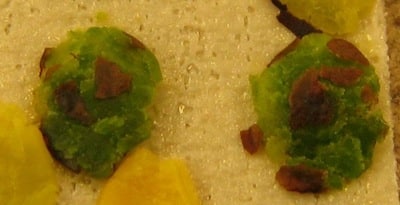Frost stops the chlorophyll-clearing process in canola seed — usually permanently. High green counts are likely in fields that were not fully mature when the heavy frost hit last week. Read the latest version of this article.
But if pods lower in the canopy were not hit hard by frost, seeds in these pods may continue to cure naturally and clear the green. Waiting will benefit these pods. Waiting may also cause seeds in severely damaged pods at the top of plants to shell out. This may reduce overall yield but could increase grade if seeds in top pods have a high green count. Scout closely to identify the extent of frost damage throughout the canopy.
Note that a killing frost may not be as killing as you think. It can happen that canola at -4°C for a few hours may not show signs of serious frost damage. Monitor these fields regularly to make sure shattering losses are not excessive. If no shattering, the extra time will benefit chlorophyll reduction.
Green that was not locked in by frost can still clear, at least to some degree, over time. Canola seed moisture needs to get back up to 20% with temperatures remaining at 15°C or warmer for chlorophyll-clearing enzymes to restart and produce significant curing. An inch of rain will not lift canola at 7-8% moisture anywhere close to 20%. Several days of heavy dew, high humidity and additional rain events may be required.
Want to know your green count? Growers who are uncertain how much green they have (“distinctly green” can be hard to determine) can send samples to the Canadian Grain Commission’s Harvest Sample Program for a free grading.
Further reading:
What’s needed to re-activate the green clearing enzyme?
Companies that buy high green canola.
